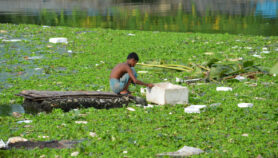By: Archita Bhatta
Send to a friend
The details you provide on this page will not be used to send unsolicited email, and will not be sold to a 3rd party. See privacy policy.
[NEW DELHI] A new study has identified bacterial strains capable of oxidising toxic arsenic into a less toxic form, offering a feasible and affordable solution to the problem of arsenic in soil and water.
Results of the study, to be published in the October 2013 issue of Science of the Total Environment, show that selected bacterial isolates of Geobacillus stearothermophilus could completely oxidise 30 millimolars of toxic inorganic arsenite (AsIII) into less toxic arsenate (AsV) within 24 hours.
While both forms of arsenic occur in nature, the removal of AsIII from environmental systems is difficult due to its relatively higher solubility, whereas AsV is poorly water-soluble and less bio-available.
The researchers isolated 12 strains of bacteria from arsenic contaminated soils in West Bengal and identified four of them as good arsenic oxidisers. While the strain AMO-10 performed the best, another strain AGH-02 was found effective in the bioremediation of soil.
"We have found these strains to be more effective than any bioengineered strains so far known," Aparajita Majumdar, a microbiologist working on arsenic mitigation at the Bidhan Chandra Krishi Viswavidyalaya, Nadiya district, West Bengal, and lead author of the paper told SciDev.Net.
The bioremediation method is far cheaper than the metal decontamination technologies currently used worldwide.
Majumdar said while G. stearothermophilus has no known pathogenic properties, more tests are required before it can be declared safe for use in bioremediation.
Arsenic toxicity in water is a major problem in the state of West Bengal and adjacent Bangladesh. The element disrupts the activity of bodily enzymes, affects skin, liver and other organs and is also known to cause cancer.
Under a World Bank-funded project, Majumdar’s team has been searching for affordable, biological ways to prevent arsenic from entering the food chain. Two types of bacteria can achieve this — one which converts arsenic into volatile methylated arsenic and another that oxidises it.
Oxidising bacteria deployed in rice paddies can reduce arsenic uptake into rice grains — a major source of toxicity in humans.
While the existence of arsenite-oxidising bacteria has been known for many years, the new paper adds to the body of knowledge in the area, says David Polya, professor of environmental geochemistry, school of earth, atmospheric and environmental sciences, University of Manchester.
Polya cautions, however, that bioremediation methods using G. stearothermophilus need to be studied further.
Link to article in Science of the Total Environment














